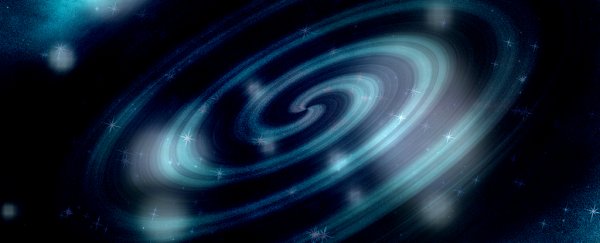Back in February, physicists gave us one of the most exciting scientific discoveries of the century - the first direct evidence of gravitational waves. These waves are like ripples that expand after a major event in space, such as two black holes merging or the explosion of a massive star.
The discovery gave us a whole new way of looking at the Universe, and that's something two physicists in Spain are taking advantage of, by testing out another scientific hypothesis: string theory. And if their ideas are correct, it could fundamentally change our thinking about the nature of the Universe.
First off, it's important to understand how gravitational waves work. In the very early Universe, everything was much denser than it is now, which resulted in a great deal of light scattering. Those photon signals can be a big problem when it comes to peering deep into the Universe to look back in time, because there's so much background noise to take into account.
What makes gravitational waves special is that their movements don't appear to be affected by interfering electrons and protons. In fact, gravitational waves might allow us to observe objects and events that don't emit any light at all, including the cosmic 'strings' that underlie the famous string theory hypothesis.
String theory aims to provide a unified approach to explaining the fundamental structure of the Universe. It suggests that cosmic strings - incredibly long and thin defects in the curvature of space and time - formed right after the Big Bang. Unfortunately, these cosmic strings are thought to have been obliterated many aeons ago, so find a large number of them, we'd have to go back to the earliest moments of the Universe.
And that brings us back to gravitational waves. Physicists Isabel Fernandez-Nunez and Oleg Bulashenko of the University of Barcelona think that one could lead us to the other - gravitational waves could help us find cosmic strings.
Fernandez-Nunez and Bulashenko started off by picturing a string as a sharp crease in space-time, and then calculated how a gravitational wave would pass through that crease. If we can find wave ripples that match these calculations, then we might have evidence of a cosmic string, they suggest.
There are hurdles to overcome before we can test out their hypothesis, because right now, we don't have the kind of technology to measure gravitational waves in the way that the pair's hypothesis requires. Plus we'd also have to be very lucky to find a pattern of just the right intensity from our position on Earth.
But these are still early days for gravitational wave astronomy, so scientists are still sharing ideas about how we might be able to make the most of this discovery.
The researchers' paper is available on pre-print website, arXiv.org, but has yet to be peer-reviewed by other astrophysicists, so we'll have to wait and see what the community makes of their hypothesis before we can get too excited. That said, this isn't the first time that scientists have speculated that gravitational waves could lead us to cosmic strings.
B.S. Sathyaprakash from Cardiff University in the UK, who works at the observatory where gravitational waves were first measured, thinks a lot of new such discoveries could be just around the corner. "I am pretty confident that within the next three or four years we will be making detections one by one and ticking the boxes," he told Tim Radford at The Guardian.
We can't wait to see what they find.
